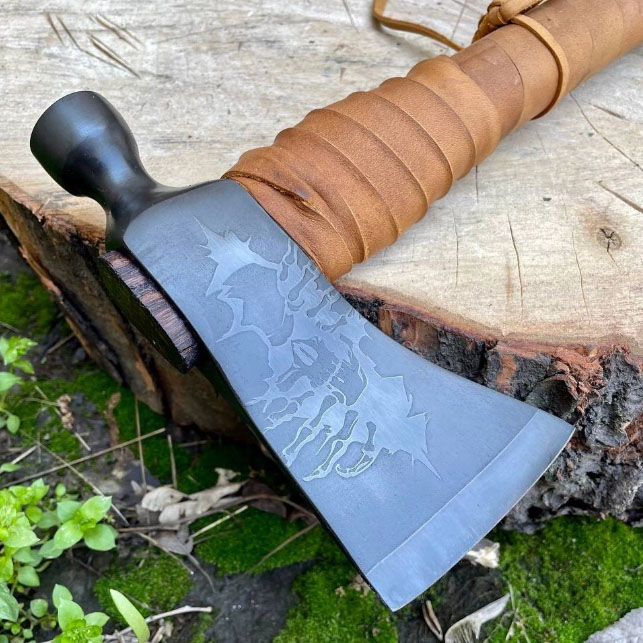Tactical Hatchet: Your Essential Tool for Camping and Outdoor Adventures

A tactical hatchet is a versatile tool primarily designed to aid in building campsites and performing various outdoor tasks. In this article, you will learn how to use a tactical hatchet to create a successful campsite and discover the unique features that distinguish this tool. We also reveal which Gorillas BBQ hatchets are best for campsite construction.
Applications of a Tactical Hatchet
First and foremost, it excels in wood-related tasks such as chopping, cutting branches, and preparing firewood. Due to its design, the tactical hatchet is also useful for constructing simple shelters and camouflage, for example, from branches and leaves. Its build allows for performing tasks with greater force and precision, thus faster and more efficiently.
Pay attention to the shape of the handle. Depending on how the hatchet fits in your hand, the strikes will vary in intensity. The shape also influences stability and precision, providing a more secure grip and preventing the handle from slipping out of your hand.
In emergency situations, the tactical hatchet can serve as a rescue tool, for example, for breaking windows or opening doors. Its sharp and durable tip is also used for breaking ice (to make an ice hole) or digging trenches.
When comparing a tactical hatchet to other survival tools like a camping knife, axe, or hammer, it becomes clear that the tactical hatchet combines the features of all these tools. It is versatile, durable, and easy to use, making it an indispensable item for any survival enthusiast building their campsite.
Features of a Good Tactical Hatchet
A well-designed hatchet has an ergonomic handle that ensures a firm grip during use. The overall length of a hatchet typically ranges from 30 to 50 cm, making it easy to carry and store while traveling. The blade length of a tactical hatchet can vary but usually falls between 5 to 15 cm.
A tactical hatchet is made from solid stainless steel, ensuring its durability and resistance to corrosion. The weight of the product can vary depending on the model but generally ranges from 500 g to 1 kg. This weight is suitable for performing the complex tasks required for building a campsite in the forest.
Stainless steel is resistant to corrosion, and its blade remains sharp. The tactical hatchet boasts high-quality craftsmanship, which directly translates to its durability and reliability in challenging conditions. The visual aspect also matters, as various symbols or graphics have long been known to add special power to tools, enhancing their value.
How to Build a Campsite Using Only a Hatchet?
Building a campsite using only a tactical hatchet is an art that requires experience, planning, and determination. Remember that the hatchet is your best friend in the wild. Respect it, take care of it, and it will help you survive in the most extreme conditions.
Choosing a Location
The first step is to find a suitable location. It must be safe, away from dead trees and open areas (avoid clearings). It is also important to be close to a water source, but not directly by a river to avoid flooding the camp.
Additionally, the location should provide wind protection, such as dense trees or rocks. Remember! If you decide to camp in a rock crevice, carefully check for unwanted guests like snakes in larger cracks. It's best to thoroughly smoke out deeper crevices to drive out any unwelcome creatures from your resting place.
Preparing the Site
After choosing a location, start preparing the site. Use the hatchet to clear the area of branches, stones, and underbrush. Then, level the ground as much as possible to create a comfortable sleeping area.
Building a Shelter
To build a lean-to shelter, start by collecting long, thick branches for the main beam and smaller ones for side supports. Attach one end of the beam to a tree at about a meter height and rest the other end on the ground, creating an angle. Then, use the hatchet to cut smaller branches and place them parallel to the main beam, forming the walls of the shelter.
Fill the walls with smaller branches, tightly laying them between the supports. Cover the walls with a thick layer of leaves, grass, or bark to provide thermal insulation and wind protection.
Preparing a Campfire
Choose a spot for the campfire away from the shelter and surround it with stones to prevent the fire from spreading. Use the hatchet to gather dry branches, break them into smaller pieces, and stack them. Remember, you cannot light a fire within 100 meters of the tree line. This can result in a fine of several thousand złoty.
It's also important to extinguish the fire thoroughly at night for two main reasons. Firstly, fire can attract wild animals to the campsite, and more dangerously, it can cause a forest fire.
Building Camp Furniture
Here, too, the tactical hatchet proves invaluable. For building a bench, use thicker logs as legs and thin branches for the seat, securing everything and leveling it with the hatchet. For a table, use sturdy branches for legs and boards or thicker branches for the tabletop.
Note! Check the shelter daily and repair any damage. Use the hatchet efficiently to conserve energy for other tasks!
Features of a Good Tactical Hatchet in a Nutshell
Earlier, we emphasized the importance of stainless steel quality used in tactical hatchets. To conclude, we reiterate that properly tempered, hard steel keeps the blade sharp and resists corrosion or the effects of certain acids.
The shape and material of the handle also matter. A wooden handle that fits well in the hand ensures safety while building a campsite.
Choosing the right tactical hatchet depends on individual needs and preferences. Its quality and materials are crucial for its reliability and durability.


